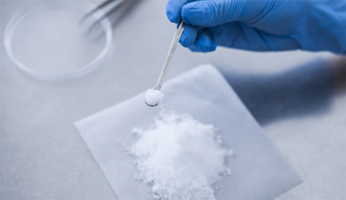
DR. WOLF BIOSCIENCE
As a sole trader I have been engaged since 1994 in development and marketing of a new class of pharmacologically active compounds – oxirane carboxylic acids – . Already since 1979 I have been engaged as a co-inventor and holder of numerous patents (substance and indication patents) in the development and investigation of etomoxir, one compound of this new class of pharmacologically active compounds.
Etomoxir
Etomoxir was developed until phase II of clinical development as a new drug for diabetes 2 and heart insufficiency by Byk Gulden Pharnaceuticals (later on ALTANA AG, Constance, Germany) and MediGene AG, Planegg/Martinsried, Germany). Both companies stopped premature this promising drug development. The cause for this is irrational in the light of today’s knowledge. A good chance to develop a new drug to treat two important diseases was thrown away. Backups with better benefit/risk-ratios were not developed, so that etomoxir is the only compound used as a specific and high potent irreversible inhibitor of the carnitine palmitoyltransferase 1 (E.C. 2.3.1.21), the mitochondrial enzyme, that regulates the entrance of long-chain fatty acids into mitochondria. Etomoxir is used as an experimental tool to investigate the effects of inhibition of the long-chain fatty acid oxidation.
Aim
To deliver etomoxir and its derivatives in good quality and for a reasonable price as well as to transfer the accumulated scientific knowledge on etomoxir – this is the aim of my business today. I do this in continuation of the efforts of the BioScience Beteiligungs Anstalt (LI) which was deleted in 2013.

Curriculum vitae – Dr. Horst P. O. Wolf
| Born 1941 in Leipzig, married, 5 children, German citizenship. |
| Study of chemistry/biochemistry at the Technical High School Leuna-Merseburg and the Friedrich-Schiller-University of Jena (Germany). |
| Promotion at the Faculty of Veterinary Medicine, University of Leipzig (Germany) in 1970. |
| Worked 5 years as director of clinical-chemical laboratories of the Children`s Hospital, University of Leipzig (Germany). |
| Worked 19 years as senior scientist in the research laboratories of Byk Gulden Pharmaceuticals GmbH, Constance (Germany). |
| Membership: European Association for the Study of Diabetes (EASD). |
| Since 1994 sole trader and scientific consultant. |
| Author/co-author of numerous scientific publications and inventor/coinventor of drugs (e. g. Daxas). |
| Languages: German, English. |
After inhibition of CPT 1 by Etomoxir the fatty acids utilization is limited and the other substrates as glucose, lactate and ketones are used for energy production according to the “glucose-fatty acid cycle” proposed by Randle and co-workers in (Lancet 1 (1963) 785-789).
Oxidation of glucose theoretically needs 13 % less oxygen for the same energy yield (ATP regeneration) than oxidation of fatty acids. …more
Etomoxir inhibits ketogenesis, gluconeogenesis, and increases glucose oxidation in fasted and diabetic animals (ref. 11; 41) and humans (ref. 19; 89) by lowering the rate of long-chain fatty acid oxidation. As a consequence, the NADH2 /NAD ratio is decreased and the end-product of the ß-oxidation – acetyl-CoA – is reduced. The reduction of acetyl-CoA limits the ketogenesis…..more
Few evidences have been reported in the last 20 years that etomoxir has anti-proliferative properties (ref. 180; 241; 243; 252; 263; 269; 277; 325). Recently, Andreeff, Taegtmeyer and colleaques from the University of Texas broke with the view that in cancer cells glycolysis dominates. They have demonstrated that free fatty acid oxidation largely supports oxygen consumption in leukemia cells and that this process is uncoupled from oxidative phosphorylation….more
Increased fatty acid oxidation and insulin resistance are associated with systemic chronic inflammatory processes as indicated by increased concentration of inflammatory cytokines, such as TNFalpha, IL-6 and C-reactive protein. These changes predict the development of arteriosclerotic alterations in type 2 diabetes….more
The ketosis is a severe metabolic disease in dairy cows with high milk production in the peripartum time phase. Today, this metabolic disease is next to milk fever and ruminal acidosis the most important disease with a incidence of approximately 12 % and leads to high annual culling rates and economical losses (Stehen, A. et al., J. Vet. Med. 44 (1997) 521-530)…..more
The following substances can be delivered for experimental use only:…more






